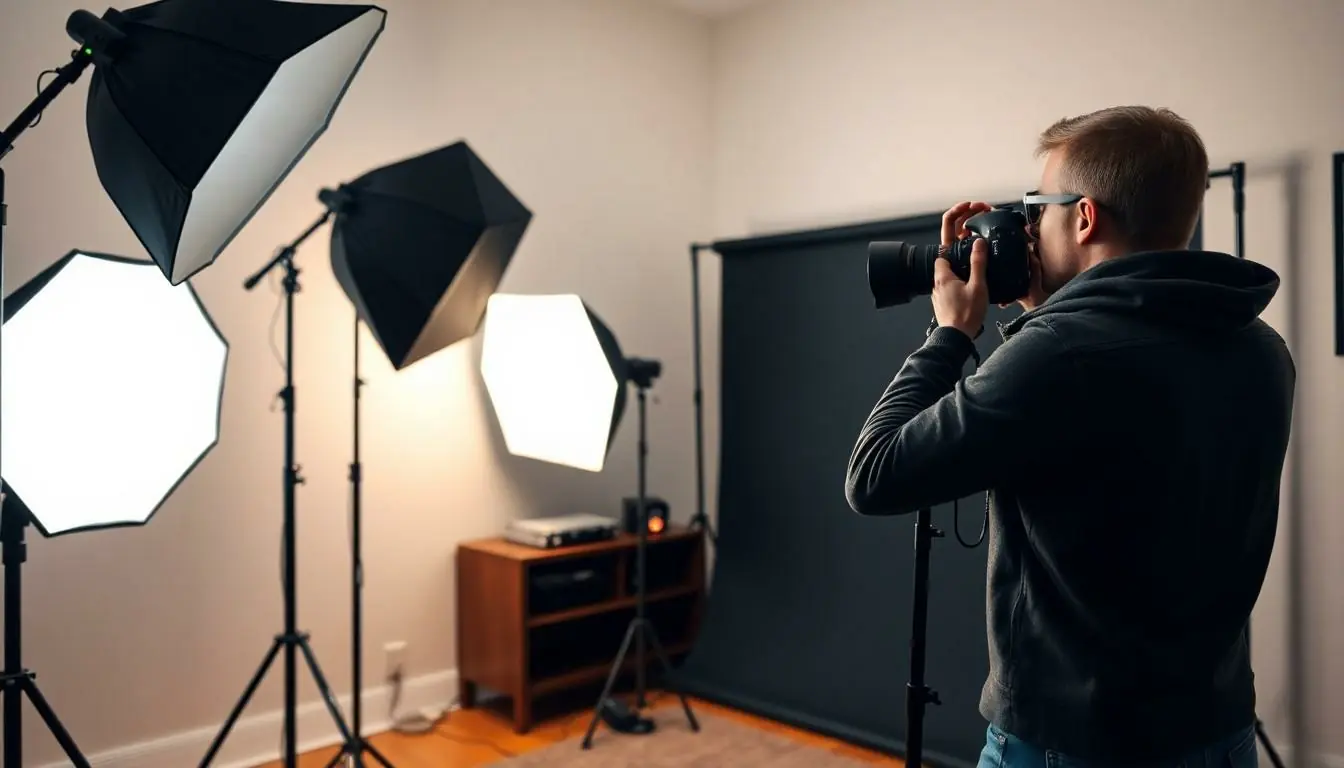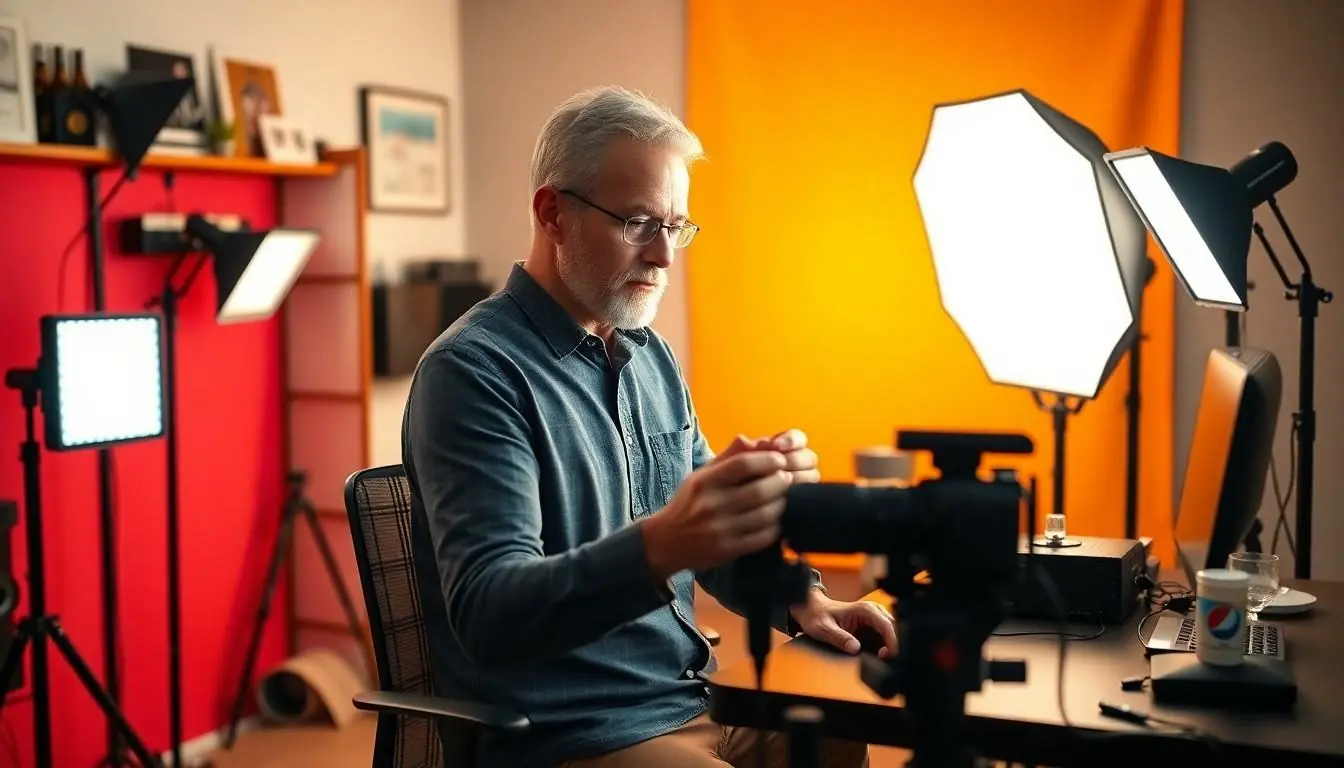Creating the perfect home studio is like baking a cake: you need the right ingredients, and lighting is the cherry on top. Whether you’re a budding photographer, a podcaster, or an aspiring YouTube star, the right lighting can transform your space from drab to fab faster than you can say “cheese!”
Table of Contents
ToggleOverview Of Home Studio Lighting
Home studio lighting plays a crucial role in achieving the desired effect for creative projects. Various light sources exist, each providing unique qualities that enhance the overall ambiance. Natural light is an excellent option, with its soft, diffused quality suitable for photography and videography. Incorporating window light and reflectors can help control shadows and highlights effectively.
Artificial lighting offers versatility through options like LED panels, softboxes, and ring lights. LED panels provide consistent brightness while maintaining low energy consumption. Softboxes diffuse light, creating a flattering and even spread across subjects. Ring lights are popular for close-up shots, delivering a distinct highlight to eyes.
Positioning lights strategically becomes essential in a home studio. Key light typically serves as the primary light source, illuminating the main subject. Fill light reduces shadows, while backlights create separation from the background. Using a three-point lighting setup enhances depth and dimensionality in images and videos.
Controlling color temperature ensures proper rendering of skin tones and backgrounds. Daylight-balanced bulbs allow for natural-looking results, while warmer bulbs add a cozy atmosphere. Adjusting the color temperature gives flexibility for different moods and styles in projects.
Evaluating the space’s size and layout helps determine the necessary equipment. Small studios might rely on fewer light sources, while larger spaces require more extensive setups. Understanding these dynamics enables creators to tailor lighting to their specific needs.
Overall, mastering home studio lighting involves combining various techniques and tools. Prioritizing the right light sources, positioning, and color ensures creators achieve professional-looking results in their endeavors.
Types Of Home Studio Lighting

Understanding the various types of home studio lighting helps create the perfect atmosphere for any project. Two primary categories of lighting exist—continuous lighting and flash lighting.
Continuous Lighting
Continuous lighting provides a steady light source ideal for real-time adjustments. It includes options like LED panels and fluorescent bulbs, offering consistent illumination that simplifies monitoring shadows and highlights. Natural color temperatures are often achievable, allowing for accurate color representation. Continuous lights enable smooth video recording and photography, as they mimic daylight conditions. Softboxes can diffuse harsh light, creating gentle shadows that enhance visual appeal. Photographers often appreciate the ease of setup and portability that continuous lights offer, making them suitable for various spaces.
Flash Lighting
Flash lighting delivers bursts of light, making it advantageous for freezing action in photography. Common types include speedlights and studio strobes, each offering significant power and control. Photographers can adjust intensity and durations to highlight specific moments in dynamic scenes. When combined with softboxes or umbrellas, flash lighting can create soft, flattering images. Flash systems often include triggers that modern technology accommodates, allowing remote operations. This type of lighting is particularly effective in controlled settings, producing professional-quality results that capture stunning detail.
Key Considerations For Home Studio Lighting
Effective home studio lighting relies on several key factors that significantly impact the overall quality of creative work. These considerations include room size and color temperature.
Room Size
Room size plays a critical role in determining the type and amount of lighting needed. A larger space often requires more light sources to ensure even illumination across the area. Smaller rooms benefit from softer lighting to avoid harsh shadows. A well-sized room generally accommodates softboxes or LED panels that take up minimal space while still providing adequate light. Evaluating the dimensions of the studio enables better planning for lighting setups. Creating a comfortable and visually balanced atmosphere enhances productivity and creativity in any project.
Color Temperature
Color temperature influences the mood and appearance of lighting. Measured in Kelvin, color temperature affects how subjects appear on camera. A warmer temperature, around 2700K to 3000K, creates a cozy, inviting atmosphere. Cooler temperatures, ranging from 5000K to 6500K, produce a more vibrant and energizing environment. Matching color temperature with the intended mood of the project ensures consistency in the visuals. Using adjustable LED lights allows control over warmth and coolness, facilitating adjustments as needed. Proper management of color temperature leads to accurate skin tones and enhanced overall aesthetics.
Best Home Studio Lighting Options
Selecting the right lighting for a home studio significantly impacts creative work quality. Various options cater to different needs and preferences.
LED Lights
LED lights stand out for their energy efficiency and versatility. Ideal for video production, these lights offer adjustable color temperatures and brightness levels, making them suitable for different creative projects. They produce less heat than traditional bulbs, reducing the risk of temperature fluctuations in a studio. Many creatives appreciate that LED panels come in various shapes and sizes, allowing easy integration into any space. Their portability makes them great for on-the-go setups as well.
Softboxes
Softboxes provide soft, diffused lighting that reduces harsh shadows, creating a more flattering look in photography and video. Often used in conjunction with continuous lights, softboxes enable precise control over light intensity and direction. They come in various sizes, accommodating different studio setups and lighting requirements. Many professionals rely on softboxes to achieve a professional appearance in their work. Inclusive of adjustable mounts, these tools allow for easy positioning, ensuring optimal light coverage for any subject.
Effective home studio lighting is essential for anyone looking to elevate their creative projects. By understanding the nuances of different light sources and their placements, individuals can transform their spaces into professional environments. Whether it’s natural light or advanced LED setups, each option offers unique benefits that cater to various needs.
The right lighting not only enhances the visual quality of work but also influences the mood and atmosphere. By taking the time to evaluate room dimensions and color temperatures, creators can establish a balanced and inviting space. Ultimately, investing in the right lighting tools and techniques will yield impressive results, allowing creativity to shine through in every project.




